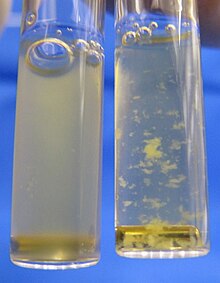Platelet aggregometry

The platelet aggregometry or platelet aggregation measurement is a laboratory test to examine the platelet function . Disorders in the functionality of platelets can result from congenital defects or can be acquired through the use of platelet aggregation inhibitors . Platelet aggregometry is helpful in finding the cause of such a dysfunction. Other methods of examining platelet function are the Rumpel-Leede test or determining the bleeding time .
Principle of the method
There are basically two different measurement methods:
- Cardinal's impedance aggregometry, a procedure presented in 1979 for the diagnosis of platelet function in whole blood.
- The Lichttransmissionsaggregometrie (LTA, " Born aggregation") method, a 1963 developed platelet-rich plasma.
With modern impedance aggregometry or multiplate electrode aggregometry (MEA), 300 µl blood is transferred into a measuring cell cuvette with a pipette . In contrast to Born aggregation, there is no need to centrifuge platelet-rich and platelet-poor plasma . In addition, the measurement takes place in whole blood, i.e. the physiological environment of the body.
In the Born method , platelet-rich plasma (PRP) is first obtained from a whole blood sample by centrifugation at a low G number. To prevent the onset of blood clotting , the blood sample usually contains 3.8% sodium citrate as an anticoagulant . The PRP obtained in this way consists of blood plasma and a large number of platelets, but practically no other blood cells . When viewed, it appears much more cloudy than ordinary blood plasma, which is actually due to the platelets.
The PRP is carefully lifted off with a pipette and transferred to a translucent cuvette . In order to test the functionality of the platelets, an agonist is added to the PRP in an analyzer to measure the turbidity with the aid of light (tubidimetric method) . The onset of aggregation leads to the clarification of the PRP and thus to a higher light permeability (increasing transmission ). The increase in transmission within a given time is directly related to the aggregation of platelets. Depending on which agonist was selected for activation, the results allow conclusions to be drawn about the functionality of the platelets. In addition to the increase in transmission, speed and curve shape during aggregation are also important for assessing platelet function. Adenosine diphosphate (ADP), epinephrine (adrenaline) and collagen are usually used as agonists . The activation causes the formation of the glycoprotein GP IIb / IIIa on the surface of the platelets. This allows fibrinogen to bind to the GP IIb / IIIa and thus link many platelets together. It created units of platelets.
Disruptive influences on the test result
The test method depends on the sample collection (preanalytics):
- Severe shear stress when taking the blood samples can lead to pre-activation and falsify the results. This can be avoided by using cannulas with a wide lumen.
- The blood samples should not be stored cold but at room temperature. Cold can also activate platelets.
- Outside of the body, the platelets fail to function properly. In order to avoid false results, a sample should be tested within 3.5 hours.
- If the number of platelets in the test mixture is too low, there are not enough platelets available to form aggregates. The cause could be a too low platelet count in the blood sample or a too high G-count during centrifugation.
Since no standardized commercial control is available, a sample from an apparently healthy donor should always be carried. However, the control donor must not have taken any anti-platelet drugs. (Source 2)
literature
The following articles seem suitable for deepening the topic:
- BE Kehrel, Platelets: Biochemistry and Physiology. Hemostaseology 2003; 23 149-58, Schattauer.
- RE Scherf, Congenital and Acquired Thrombocytopenias. Hemostaseology 2003; 23, pp. 159-69, Schattauer.
- RE Scherf, Congenital and Acquired Platelet Dysfunction. Hemostaseology 2003; 23, pp. 170-80, Schattauer.
- M. Barthels, M. von Depka, The Coagulation Compendium . Thieme, ISBN 3-13-131751-5 .
swell
- M. Barthels, M. von Depka, The Coagulation Compendium . Thieme, ISBN 3-13-131751-5 .
- L. Thomas, laboratory and diagnosis. TH-Bools Verlagsgesellschaft, 6th edition 2005, ISBN 3-9805215-5-9 .

